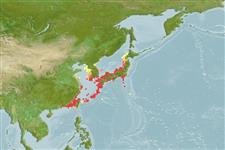>
Gobiiformes (Gobies) >
Gobiidae (Gobies) > Gobionellinae
Etymology: Rhinogobius: Greek, rhinos = nose + Latin, gobius = gudgeon (Ref. 45335).
Issue
This species is synonym of Rhinogobius similis Gill, 1859 according to Suzuki et al., 2015 (Ref. 104791). The species page will be removed.
Environment: milieu / climate zone / depth range / distribution range
Ecologie
marien; zoet water; brak water demersaal; amfidroom (Ref. 51243). Subtropical; 45°N - 22°N
Asia: China, Korean Peninsula, Taiwan, and Japan (Ref. 559) and Viet Nam (Ref. 44416).
Lengte bij maturiteit / Grootte / Gewicht / Leeftijd
Maturity: Lm 4.7 range ? - ? cm
Max length : 12.1 cm TL mannelijk / geslacht onbekend; (Ref. 114983); common length : 7.5 cm SL mannelijk / geslacht onbekend; (Ref. 35840); max. gepubliceerd gewicht: 14.90 g (Ref. 114983)
Dorsale stekels (totaal): 7; Dorsale zachte stralen (totaal): 8; Anale stekels 1; Anale zachte stralen: 8
Found both upstream and in estuaries. Carnivorous. Spawning season from July to October. Eggs are laid under stones in river shoals. Larvae travel in both river and the sea, and return to rivers from September to November. Caught by small trap nets in rivers, but not in abundance.
Levenscyclus en paargedrag
Maturiteit | Voortplanting | Paaien | Eieren | Fecunditeit | Larven
Masuda, H., K. Amaoka, C. Araga, T. Uyeno and T. Yoshino, 1984. The fishes of the Japanese Archipelago. Vol. 1. Tokai University Press, Tokyo, Japan. 437 p. (text). (Ref. 559)
Status op de Rode Lijst van het IUCN (Ref. 130435)
Gevaar voor de mens
Harmless
Gebruik door de mens
Visserij: visserij voor eigen gebruik
Meer informatie
ReferentiesAquacultuurAquacultuurprofielKweeklijnenGeneticaElectrophoresesErfelijkheidZiektesVerwerkingNutrientsMassaconversie
Tools
Speciale rapporten
Download XML
Internetbronnen
Estimates based on models
Preferred temperature (Ref.
123201): 17.2 - 26, mean 22.4 °C (based on 245 cells).
Fylogenetische diversiteitsindex (Ref.
82804): PD
50 = 0.5000 [Uniqueness, from 0.5 = low to 2.0 = high].
Bayesian length-weight: a=0.00933 (0.00739 - 0.01179), b=3.08 (3.01 - 3.15), in cm total length, based on LWR estimates for this species (Ref.
93245).
Trofisch niveau (Ref.
69278): 3.2 ±0.43 se; based on food items.
Generation time: 1.1 ( na - na) years. Estimated as median ln(3)/K based on 1
growth studies.
Weerstandsvermogen (Ref.
120179): Hoog, minimale populatieverdubbelingstijd minder dan 15 maanden (Preliminary K or Fecundity.).
Fishing Vulnerability (Ref.
59153): Low vulnerability (14 of 100).
